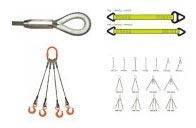Wire rope failure stops business in its tracts and puts employees in danger. The biggest responsibility of managers and bosses should be to keep their workers happy and safe. When you understand the common causes of wire rope failure, you can ensure that your wire ropes and nylon slings are maintained properly.
Abrasion breaks happen at points where ropes rub against other materials (i.e., a sheave or drum). The problem also occurs when wire ropes are struck by external objects, like shelving and crane girders. Similar types of damage occur when ropes are used on improperly grooved sheaves and drums. When a rope breaks because of abrasion, ropes begin to show worn ends.
Corrosion breaks are typically caused as a result of improper lubrication. This problem is easy to identify because wire ropes show a pitted surface on individual wires. If the problem occurs on internal wires, it is much harder to detect, making corrosion the most dangerous form of rope deterioration.
Fatigue breaks happen as a result of continual bending over sheaves. The problem creates cracks in individual wires. Broken wires begin to form in small sections before eventually moving to more sheaves. Ropes with small sheaves (concerning the diameter of ropes) have high bending fatigue. The problem will continue to get worse as ropes travel over a grooved single layer drum.
Tension failure occurs when a wire rope and nylon sling are overloaded. Overloads vary from rope to ropes because of different lifting capacities. Excessive tension placed on any rope typically causes it to break. Shock loading is the number one culprit of creating tension failure.
Nylon Slings